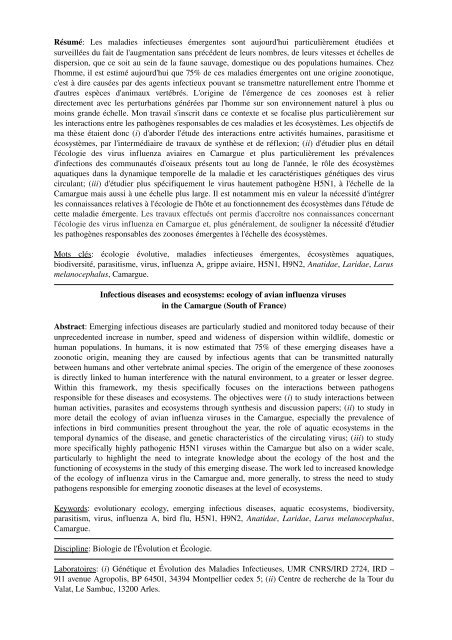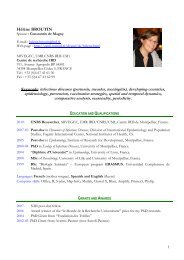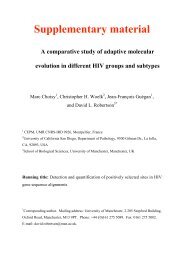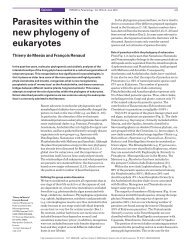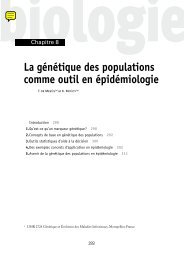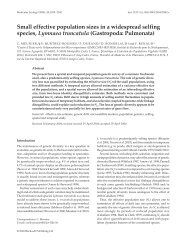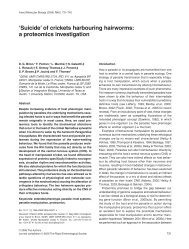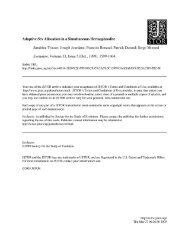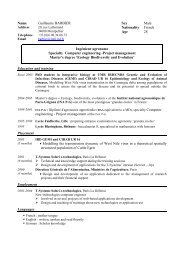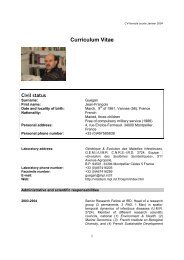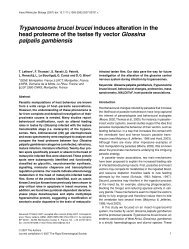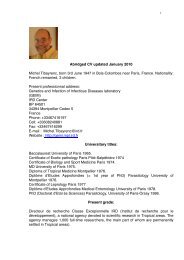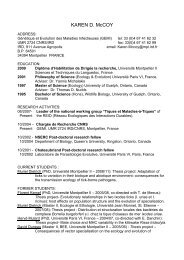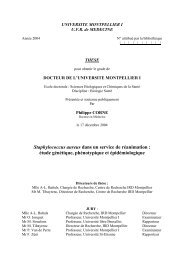écologie des virus influenza aviaires en Camargue - IRD
écologie des virus influenza aviaires en Camargue - IRD
écologie des virus influenza aviaires en Camargue - IRD
Create successful ePaper yourself
Turn your PDF publications into a flip-book with our unique Google optimized e-Paper software.
Résumé: Les maladies infectieuses émerg<strong>en</strong>tes sont aujourd'hui particulièrem<strong>en</strong>t étudiées etsurveillées du fait de l'augm<strong>en</strong>tation sans précéd<strong>en</strong>t de leurs nombres, de leurs vitesses et échelles dedispersion, que ce soit au sein de la faune sauvage, domestique ou <strong>des</strong> populations humaines. Chezl'homme, il est estimé aujourd'hui que 75% de ces maladies émerg<strong>en</strong>tes ont une origine zoonotique,c'est à dire causées par <strong>des</strong> ag<strong>en</strong>ts infectieux pouvant se transmettre naturellem<strong>en</strong>t <strong>en</strong>tre l'homme etd'autres espèces d'animaux vertébrés. L'origine de l'émerg<strong>en</strong>ce de ces zoonoses est à relierdirectem<strong>en</strong>t avec les perturbations générées par l'homme sur son <strong>en</strong>vironnem<strong>en</strong>t naturel à plus oumoins grande échelle. Mon travail s'inscrit dans ce contexte et se focalise plus particulièrem<strong>en</strong>t surles interactions <strong>en</strong>tre les pathogènes responsables de ces maladies et les écosystèmes. Les objectifs dema thèse étai<strong>en</strong>t donc (i) d'aborder l'étude <strong>des</strong> interactions <strong>en</strong>tre activités humaines, parasitisme etécosystèmes, par l'intermédiaire de travaux de synthèse et de réflexion; (ii) d'étudier plus <strong>en</strong> détaill'écologie <strong>des</strong> <strong>virus</strong> <strong>influ<strong>en</strong>za</strong> <strong>aviaires</strong> <strong>en</strong> <strong>Camargue</strong> et plus particulièrem<strong>en</strong>t les préval<strong>en</strong>cesd'infections <strong>des</strong> communautés d'oiseaux prés<strong>en</strong>ts tout au long de l'année, le rôle <strong>des</strong> écosystèmesaquatiques dans la dynamique temporelle de la maladie et les caractéristiques génétiques <strong>des</strong> <strong>virus</strong>circulant; (iii) d'étudier plus spécifiquem<strong>en</strong>t le <strong>virus</strong> hautem<strong>en</strong>t pathogène H5N1, à l'échelle de la<strong>Camargue</strong> mais aussi à une échelle plus large. Il est notamm<strong>en</strong>t mis <strong>en</strong> valeur la nécessité d'intégrerles connaissances relatives à l'écologie de l'hôte et au fonctionnem<strong>en</strong>t <strong>des</strong> écosystèmes dans l'étude decette maladie émerg<strong>en</strong>te. Les travaux effectués ont permis d'accroître nos connaissances concernantl'écologie <strong>des</strong> <strong>virus</strong> <strong>influ<strong>en</strong>za</strong> <strong>en</strong> <strong>Camargue</strong> et, plus généralem<strong>en</strong>t, de souligner la nécessité d'étudierles pathogènes responsables <strong>des</strong> zoonoses émerg<strong>en</strong>tes à l'échelle <strong>des</strong> écosystèmes.Mots clés: écologie évolutive, maladies infectieuses émerg<strong>en</strong>tes, écosystèmes aquatiques,biodiversité, parasitisme, <strong>virus</strong>, <strong>influ<strong>en</strong>za</strong> A, grippe aviaire, H5N1, H9N2, Anatidae, Laridae, Larusmelanocephalus, <strong>Camargue</strong>.Infectious diseases and ecosystems: ecology of avian <strong>influ<strong>en</strong>za</strong> <strong>virus</strong>esin the <strong>Camargue</strong> (South of France)Abstract: Emerging infectious diseases are particularly studied and monitored today because of theirunpreced<strong>en</strong>ted increase in number, speed and wid<strong>en</strong>ess of dispersion within wildlife, domestic orhuman populations. In humans, it is now estimated that 75% of these emerging diseases have azoonotic origin, meaning they are caused by infectious ag<strong>en</strong>ts that can be transmitted naturallybetwe<strong>en</strong> humans and other vertebrate animal species. The origin of the emerg<strong>en</strong>ce of these zoonosesis directly linked to human interfer<strong>en</strong>ce with the natural <strong>en</strong>vironm<strong>en</strong>t, to a greater or lesser degree.Within this framework, my thesis specifically focuses on the interactions betwe<strong>en</strong> pathog<strong>en</strong>sresponsible for these diseases and ecosystems. The objectives were (i) to study interactions betwe<strong>en</strong>human activities, parasites and ecosystems through synthesis and discussion papers; (ii) to study inmore detail the ecology of avian <strong>influ<strong>en</strong>za</strong> <strong>virus</strong>es in the <strong>Camargue</strong>, especially the preval<strong>en</strong>ce ofinfections in bird communities pres<strong>en</strong>t throughout the year, the role of aquatic ecosystems in thetemporal dynamics of the disease, and g<strong>en</strong>etic characteristics of the circulating <strong>virus</strong>; (iii) to studymore specifically highly pathog<strong>en</strong>ic H5N1 <strong>virus</strong>es within the <strong>Camargue</strong> but also on a wider scale,particularly to highlight the need to integrate knowledge about the ecology of the host and thefunctioning of ecosystems in the study of this emerging disease. The work led to increased knowledgeof the ecology of <strong>influ<strong>en</strong>za</strong> <strong>virus</strong> in the <strong>Camargue</strong> and, more g<strong>en</strong>erally, to stress the need to studypathog<strong>en</strong>s responsible for emerging zoonotic diseases at the level of ecosystems.Keywords: evolutionary ecology, emerging infectious diseases, aquatic ecosystems, biodiversity,parasitism, <strong>virus</strong>, <strong>influ<strong>en</strong>za</strong> A, bird flu, H5N1, H9N2, Anatidae, Laridae, Larus melanocephalus,<strong>Camargue</strong>.Discipline: Biologie de l'Évolution et Écologie.Laboratoires: (i) Génétique et Évolution <strong>des</strong> Maladies Infectieuses, UMR CNRS/<strong>IRD</strong> 2724, <strong>IRD</strong> –911 av<strong>en</strong>ue Agropolis, BP 64501, 34394 Montpellier cedex 5; (ii) C<strong>en</strong>tre de recherche de la Tour duValat, Le Sambuc, 13200 Arles.


